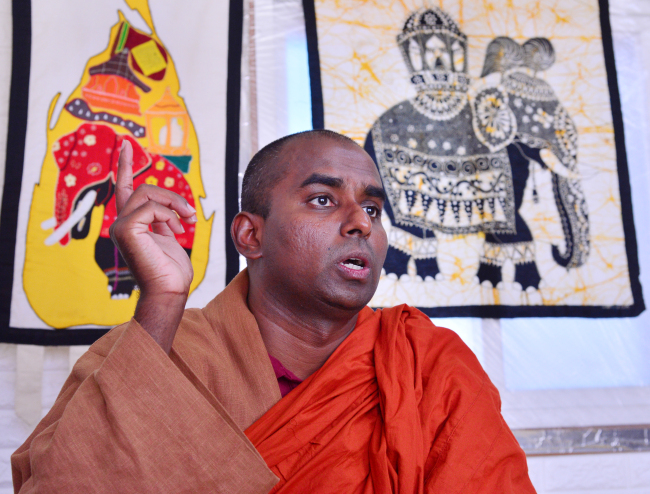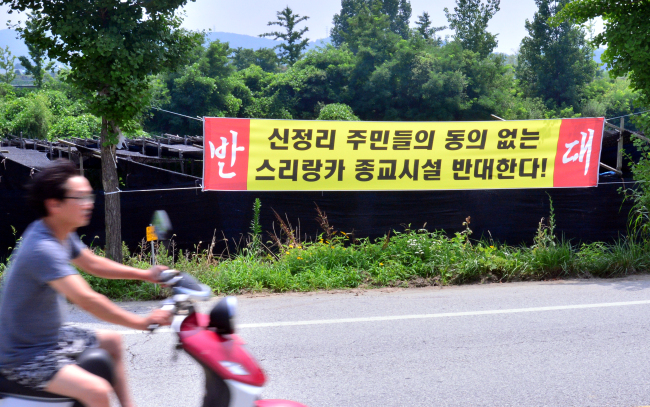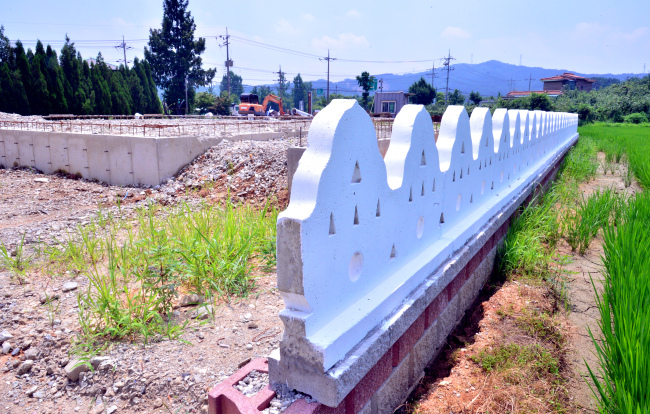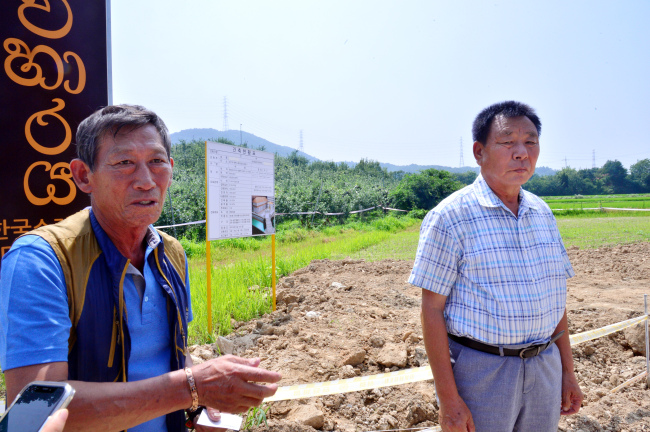ASAN, South Chungcheong Province -- Next to a bus stop marking the entrance of Sinjeong-ri village in Asan lies a construction site where work has stopped at the early stages.
The site has been marked for a Sri Lankan Buddhist temple, the construction of which has been suspended due to opposition from nearby residents, who say a large influx of foreigners would cause trouble in their farming village.
 |
Chief monk Ven. Thalgamuwa Dhammakitti speaks to The Korea Herald at the Korea-Sri Lankan Mahaviharaya Center in Pyeongtaek, Gyeonggi Province, on July 17. |
“We have no administrative problem with building the temple here. But we decided to stop the construction for a while to resolve the conflicting situations here,” chief monk Ven. Thalgamuwa Dhammakitti of the Korea-Sri Lankan Mahaviharaya Center told The Korea Herald on July 17.
The Korea-Sri Lanka Mahaviharaya Center was established in Pyeongtaek, Gyeonggi Province, in 2014 by Dhamma Friends, a religious community led by Dhammakitti. But due to a change in the land law in 2016, they could not establish more buildings in Pyeongtaek and decided to relocate to Sinjeong-ri, some 15 kilometers away.
“I think there is a misunderstanding, and we want to resolve it, but they are not giving us a chance,” Dhammakitti said.
The community of Sinjeong-ri, however, is unwilling to accept the foreign temple, where hundreds of Sri Lankans are likely to regularly visit, head of the village Lee Guk-hwan told The Korea Herald.
“We are worried that these foreigners will cause security and noise problems in our quiet village. It is inevitable that conflicts will be created between residents and foreigners when they come,” Lee said. The village comprises about 50 households, mainly elderly, according to Lee.
 |
A banner reads, “(We) oppose Sri Lankan religious temple coming in without consent from Sinjeong-ri people,” on a street in Sinjeong-ri, Asan, South Chungcheong Province. (Park Hyun-koo/The Korea Herald) |
“Similar to other religious facilities, they may bring in illegal migrants to protect them against repatriation. Besides, we cannot accept our village becoming the headquarters of thousands of Sri Lankans in the country,” Lee added.
On the streets of the village hung placards reading, “Oppose Sri Lankan religious temple coming in without consent from Sinjeong-ri people.” Lee has submitted a petition against the temple construction to Asan City Hall, signed by 2,844.
Misunderstandings and prejudice
The construction of a 185-square-meter building began in April, after obtaining a permit from the city government.
“We were aware of a religious temple coming in and we wondered, ‘Why here?’ But we did not pay much attention to it in the beginning,” Lee said.
Complaints began streaming in from May. On Vesak Day, locally known as Buddha’s Birthday, which fell on May 20, some 400 Sri Lankans and “outsiders” gathered at the construction site for a celebration.
“Strange looking flags were set up around the village and loudspeakers were blaring incomprehensible words. Hundreds of dark-skinned foreigners were everywhere,” Lee said.
Many complaints were filed concerning the noise, and two police cars also came to watch over the scene at the time, Lee said.
 |
The construction site of Mahaviharaya temple in Shinjeong-ri, Asan, South Chungcheong Province. (Park Hyun-koo/The Korea Herald) |
“They (the temple) did not give us any notification about the event -- none. The village people were frightened. It would not have been so bad if they had come to us to ask in advance.”
About the incident, Dhammakitti expressed regret.
“We made a big mistake that time. Monk Gongwoon caught a bad flu and we did not contact them beforehand. I am sorry about that, and I hope Lee and village people would allow us to speak to them about it,” he said. Gongwoon is the temple’s adviser.
Dhammakitti also said he wishes to reduce the prejudice against foreigners and will continue to make efforts to persuade the people.
“We are not here to do illegal activities, nor are we going to cause harm to the villagers. I understand that our presence may be abrupt and it will take time to adjust to the differences,” he said.
Dhammakitti, who came to Korea to study in 2009, recently became a naturalized Korean citizen.
In his first year in Korea, he created a religious fellowship group to collect funds to help Sri Lankans staying in the country. The group was renamed Dhamma Friends in 2013 and expanded to establish the Mahaviharaya center in Pyeongtaek in 2014.
“I sought to provide a place for Sri Lankans to feel at home, allow them to give sincere prayers and meet people they can share similar experiences with,” Dhammakitti said. As of July 2018, there are about 24,456 Sri Lankans staying in Korea, according to the Korea Immigration Service.
But aside from their first troubled encounter, Lee and the villagers are concerned that regular visits of Sri Lankans to the area will raise the crime rate and the temple will attract illegal migrants seeking sanctuary.
“We will not be comfortable seeing foreigners wandering around this area. What if, for example, an illegal migrant is forced into a corner and loses control? You never know what they can do, and all the harm is for us to endure,” said resident Kim Myung-bae, 70.
“The facility is for their nationals, but it is at our village entrance that they are trying to build the temple. We will continue our protest, and we may raise our voice if they do not stop and move out,” Lee said.
 |
Lee Guk-hwan (right), head of the Sinjeong-ri village, and resident Kim Myung-bae stand in front of the construction site of the Korea-Sri Lanka Mahaviharaya Temple in Sinjeong-ri, Asan, South Chungcheong Province, on July 17. (Park Hyun-koo/The Korea Herald) |
The discussion failed to achieve progress after a town meeting at the end of May. The villagers and monks plan to meet again soon. While sentiment against the temple remains, Dhammakitti says he will make efforts to inform the people about who they are, and cooperate with the villagers.
“A couple of Sri Lankans and I went to help weeding at a farm recently. We did not know about the cultural and social norms, and now we know. I will continue to inform the people of who we are,” he said.
Several factors, such as xenophobic sentiment and fear of the unfamiliar are at play in Sinjeong-ri, experts say, adding that understanding and respecting different cultural expectations are crucial in resolving such conflicts.
“It is a complex situation in Asan. It is not just xenophobia -- it is natural that people raise their guard against unfamiliar situations,” said Seol Dong-hoon, a sociology professor at Chonbuk National University. “But the situation appears to be a NIMBY phenomenon.”
Shin Sang-rok, head of the International Unity Network, also pointed to a lack of cultural understanding as one of reasons behind the opposition to the temple.
“In Korea, we have this community culture of ‘teotse,’ which is territorial sentiment against newcomers. It also happens among Koreans,” Shin said. “It is important that both sides open up to different cultural norms and show respect.”
By Jo He-rim, Chyung Eun-ju (
herim@heraldcorp.com) (
ejchyung@heraldcorp.com)








![[KH Explains] For Korean automakers, Chinese EVs may loom larger than Trump’s tariffs](http://res.heraldm.com/phpwas/restmb_idxmake.php?idx=644&simg=/content/image/2024/11/14/20241114050537_0.jpg)
![[Graphic News] Tainan predicted top destination for South Koreans in 2025](http://res.heraldm.com/phpwas/restmb_idxmake.php?idx=644&simg=/content/image/2024/11/13/20241113050807_0.gif)

![[Herald Review] Cho Seung-woo takes 'Hamlet' crown](http://res.heraldm.com/phpwas/restmb_idxmake.php?idx=644&simg=/content/image/2024/11/14/20241114050593_0.jpg)